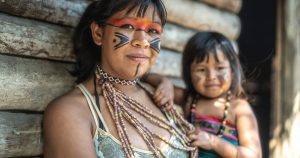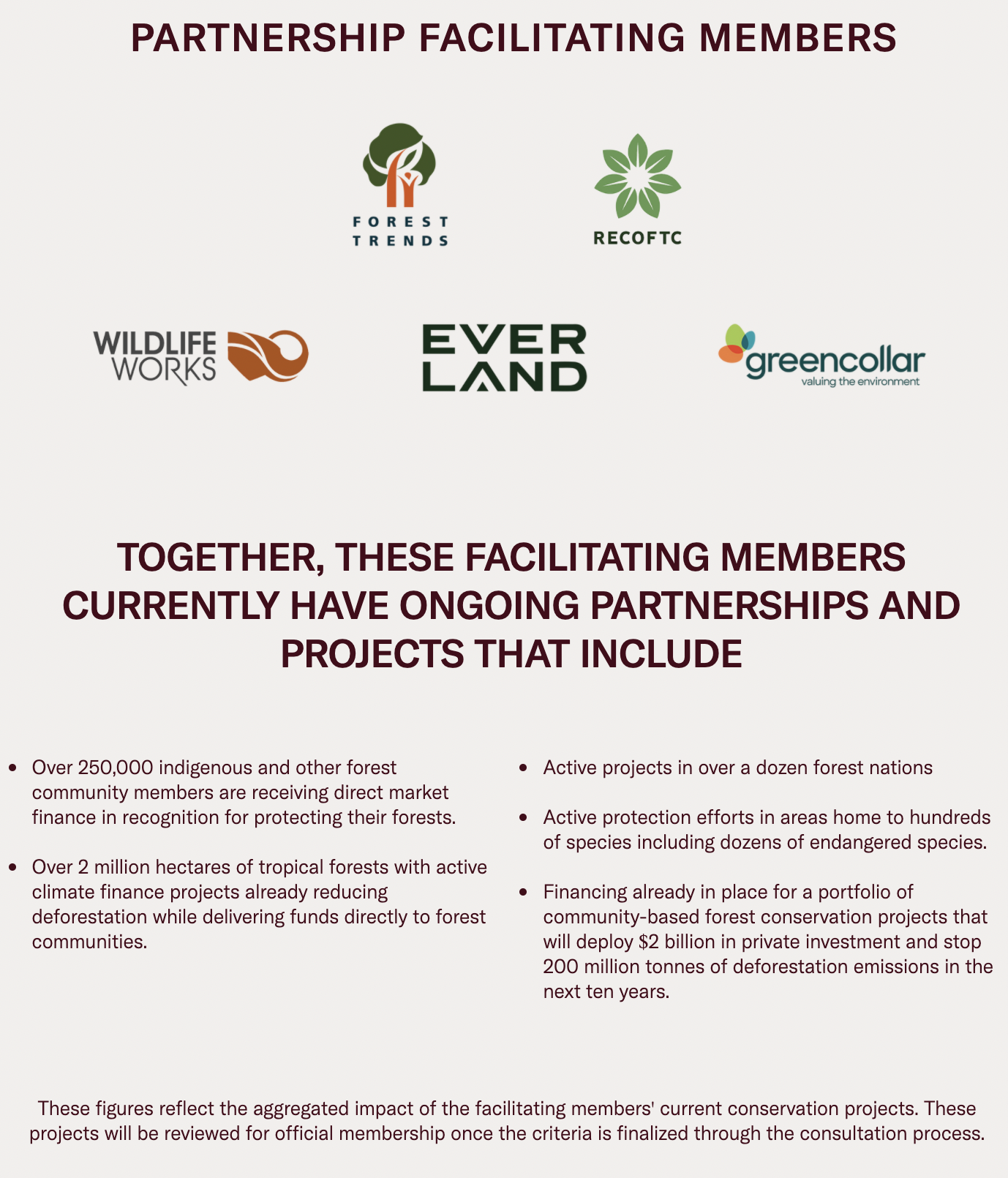New Global Partnership Opens Door for Indigenous People, Traditional Owners and Local Communities to Directly Benefit from Private Climate Finance
An industry first coalition aims to fix a fundamental market flaw: Indigenous Peoples manage one-fifth of tropical and subtropical forest carbon, and conserve 80 percent of all biodiversity yet receive less than one percent of international climate assistance

- Peoples Forests Partnership members seek to mobilize $20 billion per year by 2030 in direct private investment in community-driven forest conservation and restoration projects, and set a high standard for equitable, accessible, and culturally appropriate mechanisms for forest communities to engage with climate finance.
- As tropical forest guardians, Indigenous Peoples, traditional owners, and local communities (IPLC) are essential partners for governments and countries in order to meet Paris Agreement goals.
November 7, 2021 / The Peoples Forests Partnership, announced today at the United Nations climate summit (COP26), aims to fix a fundamental flaw in carbon financing by directing significant private funding to forest communities to reward their efforts to successfully stop deforestation.
The Partnership will include Indigenous organizations, conservation groups, companies, and investors and seeks to mobilize and direct billions of dollars in private and public-sector investments to community-based forest conservation projects. While closing a major equity gap in climate finance, the partnership will support meaningful contributions toward Paris Agreement targets, voluntary corporate climate commitments, and Nationally Determined Contributions (NDCs).
This announcement follows a November 1 pledge by a coalition of governments and philanthropic donors to channel $1.7 billion to IPLC, with a focus on improving tenure security. The Peoples Forests Partnership will provide a complementary platform for companies and investors to invest in community-based, values driven forest conservation and restoration projects.
The platform will support both performance-based payments (such as for carbon credits) as well as other climate funding mechanisms, including a financing facility specifically focused on strengthening territorial governance to be managed by Partnership member Forest Trends.
Role of IPLC in meeting Paris Agreement goals
Indigenous peoples, traditional owners, and local communities (IPLC) safeguard vast reservoirs of forest carbon. Worldwide, IPLC manage more than one-fifth of the forest carbon stored in tropical and subtropical countries.1 Indigenous communities have proven to be the world’s most effective guardians against tropical deforestation. Indigenous territories in the Amazon lost less than 0.1% of their aboveground carbon stocks between 2003-2016, compared to 3.6% for other lands.2
IPLC stewardship of forests comes at increasing costs: forest defenders face accelerating violence, political repression, and deforestation and degradation pressures from fires, agricultural interests, logging, mining, land grabbing, and other illegal activities on indigenous and other forest communities’ lands. Yet, these communities receive virtually no climate finance to support their efforts: International aid supporting IPLC forest protection is equal to less than 1% of overall Official Development Assistance for climate mitigation and adaptation.3
Peoples Forests Partnership Aims
The Peoples Forests Partnership aims to mobilize at least $20 billion per year in long-term, private-sector investments as well as public funding, and channel it directly to forest community projects by 2030. This could reduce CO2 emissions from deforestation each year by at least 2 billion tonnes, protect at least 500 million hectares of threatened tropical forest and their biodiversity, and support livelihoods and bioeconomy development for over 50 million people in forest communities.
In the coming year, additional Partnership goals are to mobilize funds for capacity-building for forest communities so they can fully participate in and benefit from carbon finance, and to advance new alternative financing instruments including for high-carbon low-deforestation forests that are particularly difficult to finance through current mechanisms.
The facilitating members of the Peoples Forests Partnership are Forest Trends, RECOFTC, Wildlife Works Carbon, Everland, and GreenCollar. The members collectively represent a portfolio of community-based forest conservation projects in more than a dozen countries across Latin America, Africa, Southeast Asia, and the Pacific.
In total, the current members have secured initial financing for a portfolio of projects that will generate $2 billion in private investment and at least 20 million tonnes per year of Verified Emission Reductions. Globally, the financing is being channeled to a quarter million indigenous and other forest community members already managing over two million hectares of tropical forests.
Call for Expressions of Interest
From today, the Partnership is actively seeking expressions of interest from organizations and individuals from forest communities, business, government, philanthropy, and civil society.
A consultation period also invites interested stakeholders to offer their input on documents of engagement, including membership criteria for high-integrity community-based projects and operating principles. A draft set of documents has been developed in consultation with select Indigenous Peoples leadership and other stakeholders.

Mateo Estrada, Organization of Indigenous Peoples of the Colombian Amazon (OPIAC); lead author of the Peoples Forests Partnership’s consultation document on Working with Indigenous Peoples, Traditional Owners, and Local Communities on Climate & Conservation Finance Projects, said:
“We, the indigenous peoples of the Colombian Amazon and the South American Amazon are very important for humanity, because we are the bearers of the knowledge to keep nature intact. It is for this reason that indigenous peoples have decided to coordinate with the Peoples Forests Partnership in their work to drive resources directly to indigenous management, so that [indigenous peoples] can improve their quality of life, improve their economy, improve their health, improve their vocation, so that women can participate, and so young people can have a better future.
“We want to be part of this, and we are already part of it, because we have participated in its design. We hope that companies, governments, and international organizations can support this great initiative.”
Beto Borges, Director of Forest Trends’ Communities and Territorial Governance Initiative, a facilitating member of the Peoples Forests Partnership, said:
“We cannot achieve Paris Agreement goals without our Indigenous and forest community partners. The world is beginning to realize this truth. We welcome recent government and philanthropic commitments to increase aid to IPLC. The Peoples Forests Partnership provides a complementary platform for increasing private-sector investment in community-based forest projects at meaningful scale with long-term durability.
“The climate finance system is still not designed to work with indigenous and traditional peoples, at a moment when they should be at the center, as equal partners in the battle against climate change. New flows of finance must reach IPLC directly and must come hand in hand with consultation as recommended in the Cancun Safeguards.”
David Ganz of RECOFTC, a facilitating member of the Peoples Forests Partnership, said:
“Very little climate finance directly benefits forest communities. Systems like REDD+ can be difficult for communities to navigate. Safeguards and requirements for free, prior, and informed consent are inconsistently followed. Benefits-sharing programs are not designed in culturally appropriate ways.”
Francisca Arara, President of the Regional Committee for Indigenous Peoples and Traditional Communities, Governors Climate and Forests Task Force, and former Political Advisor for the Association of the Movement of Indigenous Agroforestry Agents of the State of Acre, Brazil, said:
“The root of the problem is this: whoever deforests the most, earns the most. And whoever preserves, sometimes they don’t earn anything. This situation exposes the problems of climate funding. It is difficult for indigenous peoples to access these resources. Indigenous women receive even less. The world needs to know the work we do in the forests, for the climate, for the planet, and for the world. The world needs to know our culture.”
Seraphine Charo, Carbon Committee Representative, Wildlife Works Kasigau Corridor REDD+ Project, Marungu, Kenya, said:
“When a member of a forest community can feel the recognition from an international audience that becomes very empowering, and it gives more motivation for them to continue with their efforts. The next step is for that voice to be heard during discussions and decision making about forest conservation and climate change. It is also very important that funding for forest conservation reaches them on the ground.”
Mike Korchinsky, Founder and CEO of Wildlife Works, a facilitating member of the Partnership, said:
“Wildlife Works has been working directly with forest communities to protect their natural environment for over 20 years and we have seen firsthand how hard it is for them to access climate finance, and how transformative it can be when they succeed. This partnership is positioned to dramatically scale the supply of market and non-market climate finance flowing directly to forest communities, so they can play their essential role in creating global solutions to climate change.”
Joshua Tosteson, President of Everland, a facilitating member of the Partnership, said:
“At COP26 the leaders of the world have now agreed to end deforestation. But how will we accomplish this? Because forest conversion is driven by economic forces, we’ll only successfully halt deforestation if we create meaningful, durable value for forest stakeholders by keeping the forests standing, especially for the local and indigenous communities who safeguard most of the world’s remaining forests. Community-based initiatives to stop deforestation and degradation (REDD+), supported by private sector market finance, have already delivered hundreds of millions of tonnes of emissions reductions over the past decade through a ‘bottom-up’ approach that directly addresses the drivers of deforestation active in highly threatened forest areas. Through the Peoples Forests Partnership, we aim to scale this successful model by recognizing the central role of IPLCs in addressing our planetary emergency. Everland is proud to be a facilitating member of this partnership.”
Robert O’Sullivan, Chief Adviser, International Markets, GreenCollar Group, a facilitating member of the Partnership, said:
“If IPLCs receive direct and equitable access to climate finance there is tremendous potential to rapidly protect and restore international forests at scale and help meet the global pledges to halt deforestation by 2030. IPLCs are not limited to small, isolated projects. Indigenous and traditional communities manage global forest carbon stores equal to at least 33 times the worlds’ energy emissions in 2017. This under-represents the amount of stored carbon managed by IPLCs, and these forests are at risk if we do not move quickly to support communities in protecting them.”
Please see our Reprint Guidelines for details on republishing our articles.

